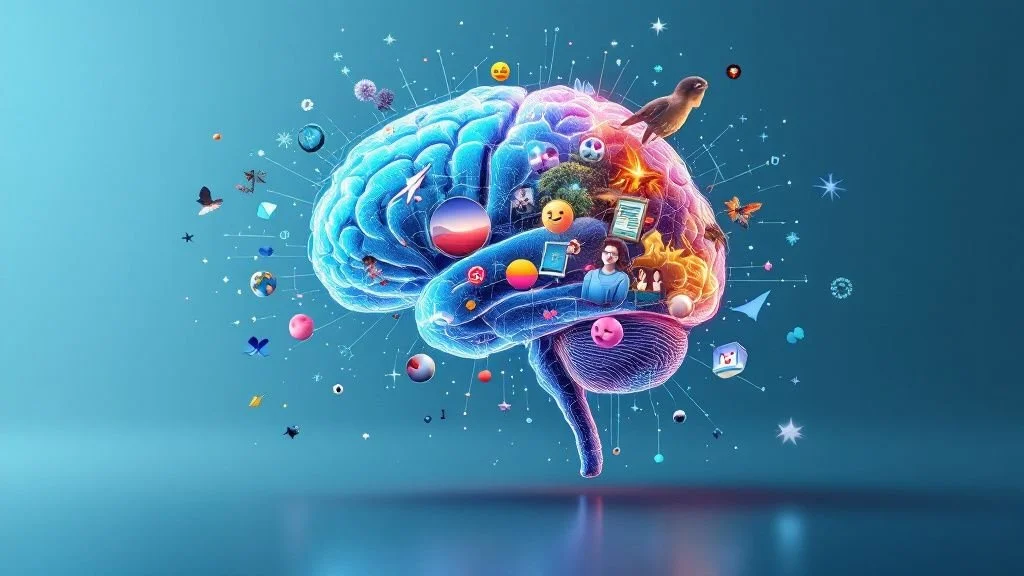The Psychology of Selling by Visual Storytelling
Key Takeaways
- Visual storytelling uses imagery to engage emotional and cognitive centers in the brain.
- It simplifies complex ideas, making them more understandable and memorable.
- Effective visual storytelling enhances brand loyalty and influences consumer decisions.
- Challenges include maintaining originality and relevance amidst content saturation.
- Future trends highlight the necessity for authentic, immersive experiences in storytelling.
Visual storytelling wields a profound influence on human perception and emotion, acting as a compelling tool in the art of persuasion. As a viewer, you are naturally drawn to narratives portrayed through imagery because they engage the brain's emotional and cognitive centers. This makes visual storytelling an essential asset in marketing, appealing to both rational and emotional motivators. By harnessing the psychology of visual storytelling, you can effectively guide potential customers through a visual journey, making products or ideas not just visible but memorable. The strategic design of images can leave lasting impressions, facilitating connections and encouraging decision-making.
Understanding Visual Storytelling
Visual storytelling taps into the brain’s natural craving for narratives, weaving a tapestry of images and emotions that connect deeply with you. This approach allows information to be absorbed in a way that feels both natural and impactful. You find yourself more inclined to remember a vibrant picture or a compelling visual sequence than a mere block of text, thus making visual storytelling a crucial aspect of effective communication.
In understanding this psychological phenomenon, it becomes clear that incorporating visuals can enhance meaning and facilitate learning. When visuals align with a narrative, they can provide you with context, clarity, and emotional engagement. These elements work collaboratively to ensure that the message leaves a lasting impression on your mind, shaping your understanding and influencing your decisions.
For example, in the fashion industry, brands like Gucci utilize visual storytelling to create not just a style statement, but an entire lifestyle. Through carefully curated visuals in advertisements and social media, you are drawn into a world of luxury and elegance, which resonates beyond the product itself. Such storytelling builds a narrative that you can relate to or aspire towards.
Visual storytelling in marketing doesn't merely present information; it paints a picture that appeals to your senses and emotions. By doing so, it fosters an emotional bond between you and the brand, facilitating a stronger relationship and promoting trust. When you encounter imagery that resonates with your values or aspirations, it encourages you to engage with the brand more deeply.
Effective visual storytelling offers you a journey that transcends the ordinary, providing a pathway to connect with an idea or product in a meaningful manner. Understanding the core principles of visual storytelling equips you with the tools to not only capture attention but to also forge lasting memories that influence choices and actions.
The Psychological Impact of Visuals
Visuals hold an extraordinary capacity to elicit strong emotions and reactions from you due to their innate ability to mirror real-life experiences. As they bypass the logical faculties of the brain, they tap directly into the emotional core, making you feel connected and engaged. This process transforms abstract concepts into tangible experiences, fostering an immediate and profound connection with the message being conveyed.
The psychological impact of visuals significantly enhances the retention of information. According to recent studies, the brain processes visuals 60,000 times faster than text, highlighting the role of imagery in facilitating quicker comprehension and retention. This rapid processing ability underscores why you might remember a vivid image or scene longer than a written description, making visual storytelling a powerful tool for effective communication.
In marketing, visuals not only attract but also hold your attention, guiding you through complex narratives effortlessly. When an advertisement or campaign utilizes strong visual elements, it creates a storyline that lingers with you, merging information with entertainment. The emotional resonance of well-crafted visuals can lead to increased brand loyalty and engagement.
Understanding these psychological effects allows content creators to design visuals that resonate with you on a deeper level. A thoughtful combination of images and stories can trigger specific emotions, prompting desired actions and fostering a lasting impression that forms the foundation of successful marketing campaigns.
Conveying Complex Ideas by Visual Storytelling
Visual storytelling excels at breaking down complex ideas into more digestible and engaging formats. When you encounter intricate concepts, visuals act as a bridge, transforming abstract data into understandable narratives. This approach enhances learning and retention by aligning complicated information with memorable imagery, resulting in a dynamic presentation that captivates and educates simultaneously.
By utilizing visual elements like infographics, diagrams, and animations, you can perceive the connections and relationships within data that might otherwise appear overwhelming. These tools simplify elaborate topics by providing a clear visual guide, creating an intuitive understanding. The effectiveness of this strategy lies in its ability to cater to visual learners, allowing you to assimilate information in a manner that suits your cognitive preferences.
One unpopular opinion about visual storytelling suggests that it sometimes oversimplifies complex ideas, potentially leading to misinterpretation. While visuals are powerful, they also carry the risk of losing nuance, requiring you to critically assess the content being presented. As you explore these visuals, it's vital to remain mindful of their limitations, considering the broader context to ensure comprehensive understanding.
In marketing, visual storytelling transforms complex product features or industry jargon into relatable stories. When you encounter a product demo or service explanation through an engaging visual narrative, it facilitates clarity, making the information more approachable and applicable. This method of storytelling not only captures interest but also motivates you to explore deeper into the brand’s offerings.
Empowering you with complex knowledge through visual storytelling requires careful design and thoughtful presentation. The strategic use of visuals to convey complicated ideas encourages active engagement, sparking curiosity and inviting you to explore subjects further. As you engage with such content, the delivery transforms into a discovery process, enhancing both insight and retention.
Telling Your Brand Story by Visual Storytelling
Visual storytelling is a compelling way to craft and communicate your brand story. By weaving together meaningful narratives and captivating visuals, you can convey your brand's essence, values, and mission in a way that resonates personally with your audience. This approach transforms your brand from a set of products or services into an experience that your audience can engage with and relate to on an emotional level.
When telling your brand story through visual storytelling, consistency and authenticity are key. Your visuals should reflect your brand’s identity and maintain a cohesive message across all platforms. This consistency helps you establish credibility and trust, creating a uniform experience for your audience that reinforces your brand story each time they interact with it.
Did you know? According to HubSpot, 54% of consumers want to see more video content from brands they love, highlighting the effectiveness of visual storytelling in marketing. Through videos, you can showcase your brand's journey, introduce key figures, and highlight successes in a dynamic format that captures the hearts and minds of viewers, prompting deeper engagement and retention.
Incorporating visual storytelling in brand marketing allows you to stand out in a crowded market space. It facilitates the creation of a unique brand personality that can attract and retain a loyal customer base. Through compelling visual narratives, you can efficiently communicate the intangible aspects of your brand, inviting your audience to join your story and become part of your brand's evolving journey.
Harnessing Visual Storytelling for Higher Sales Conversion
Visual storytelling can be a game-changer in elevating sales conversion by creating a seamless blend of emotion and information. As you engage with visually rich content, you are drawn toward narratives that highlight a product's benefits and solutions. This storytelling technique shortens the gap between awareness and purchase, enabling you to make informed decisions based on a captivating and informative journey.
Compelling visuals paired with engaging stories steer your focus and keep you invested longer. This increased attention span provides you with a more comprehensive understanding of the product or service, influencing your likelihood to convert. When marketing campaigns leverage images and videos effectively, they clarify complex offerings and foster trust, ultimately easing your path down the sales funnel.
In the next few years, visual storytelling is likely to dominate digital marketing strategies, becoming a primary driver for sales conversion. As more companies recognize its potency in capturing and holding interest, you can expect a widespread adoption of this approach. Brands that embrace this evolution will see enhanced consumer loyalty and improved conversion rates as they navigate the competitive landscape.
Harnessing the power of visual storytelling in marketing aligns with evolving consumer preferences for engaging and meaningful brand interactions. By situating intriguing narratives at the core of marketing initiatives, you are more likely to encounter content that resonates, compelling engagement, and driving sales conversions.
Challenges in Visual Storytelling
Visual storytelling faces several challenges that require careful consideration to maintain its effectiveness. Crafting a narrative that resonates universally necessitates a balance between creative expression and strategic intent. This can be difficult, as you must ensure that the visuals not only captivate but also convey the intended message clearly, without losing the essence of the brand's voice in the pursuit of artistic flair.
The oversaturation of content in today’s digital age makes it harder for your message to stand out. You are bombarded with an abundance of visual stimuli daily, meaning that storytelling efforts must be innovative and memorable to capture your attention. Creativity and originality are paramount, demanding continuous evolution to ensure that your visuals don't just blend into the background noise.
In the next few years, creating authentic and immersive experiences through visual storytelling is likely to become a necessity rather than an option. As technology advances, there will be increased pressure on brands to adopt cutting-edge techniques like augmented reality and interactive content to keep you engaged. This will elevate storytelling into an experiential domain, pushing brands to explore unprecedented realms.
Navigating these challenges requires deliberate strategies and a deep understanding of your audience. The key is to remain adaptable and responsive, ensuring that your visual storytelling efforts are not just heard but felt, forging meaningful connections that sustain interest and encourage interaction.
Frequently Asked Questions
What is visual storytelling?
Visual storytelling is the use of images, videos, and other visual elements to convey narratives and engage viewers emotionally.
How does visual storytelling impact marketing?
It enhances brand engagement by creating compelling narratives that capture attention and enhance memory retention, influencing consumer behavior.
Can visual storytelling simplify complex information?
Yes, it can break down complicated ideas into accessible visuals, aiding understanding and retention.
What challenges does visual storytelling face?
Key challenges include standing out in a saturated content landscape and maintaining authenticity and creativity.
What is the future of visual storytelling?
The future likely involves more immersive experiences using advanced technologies like augmented reality to deepen viewer engagement.





